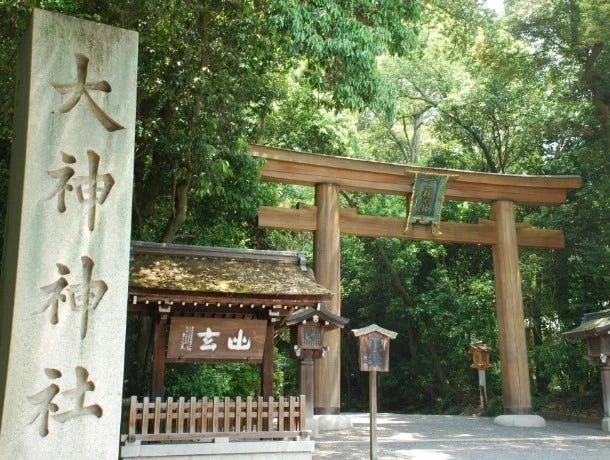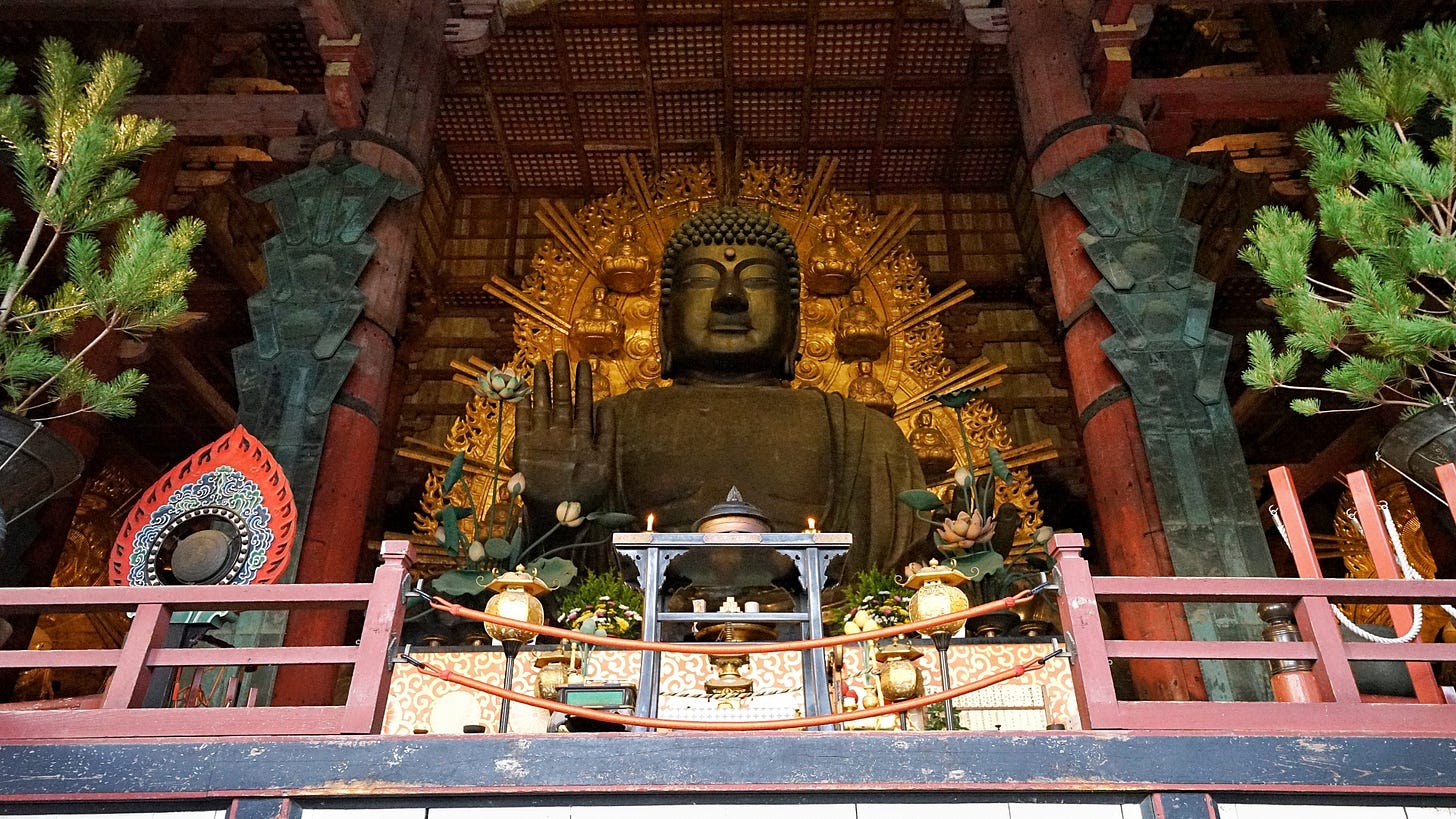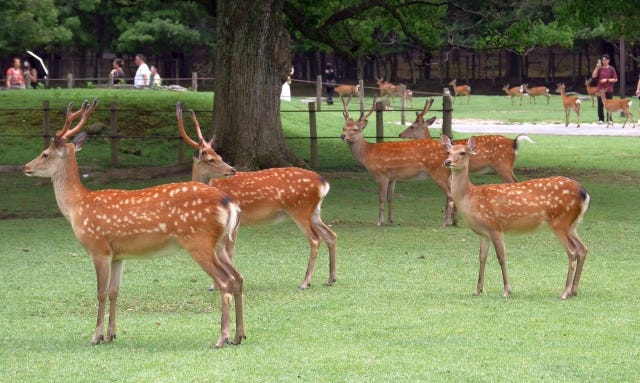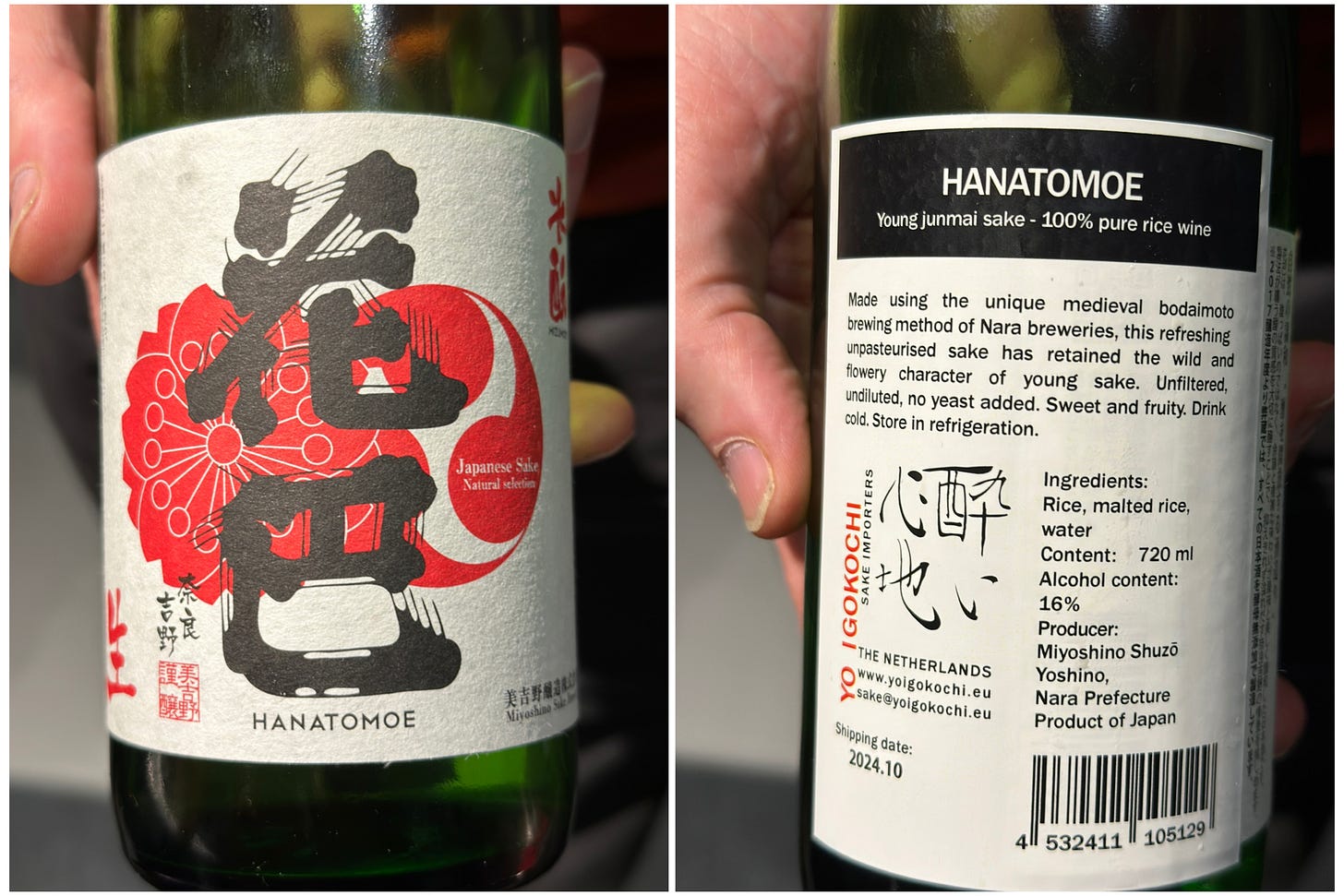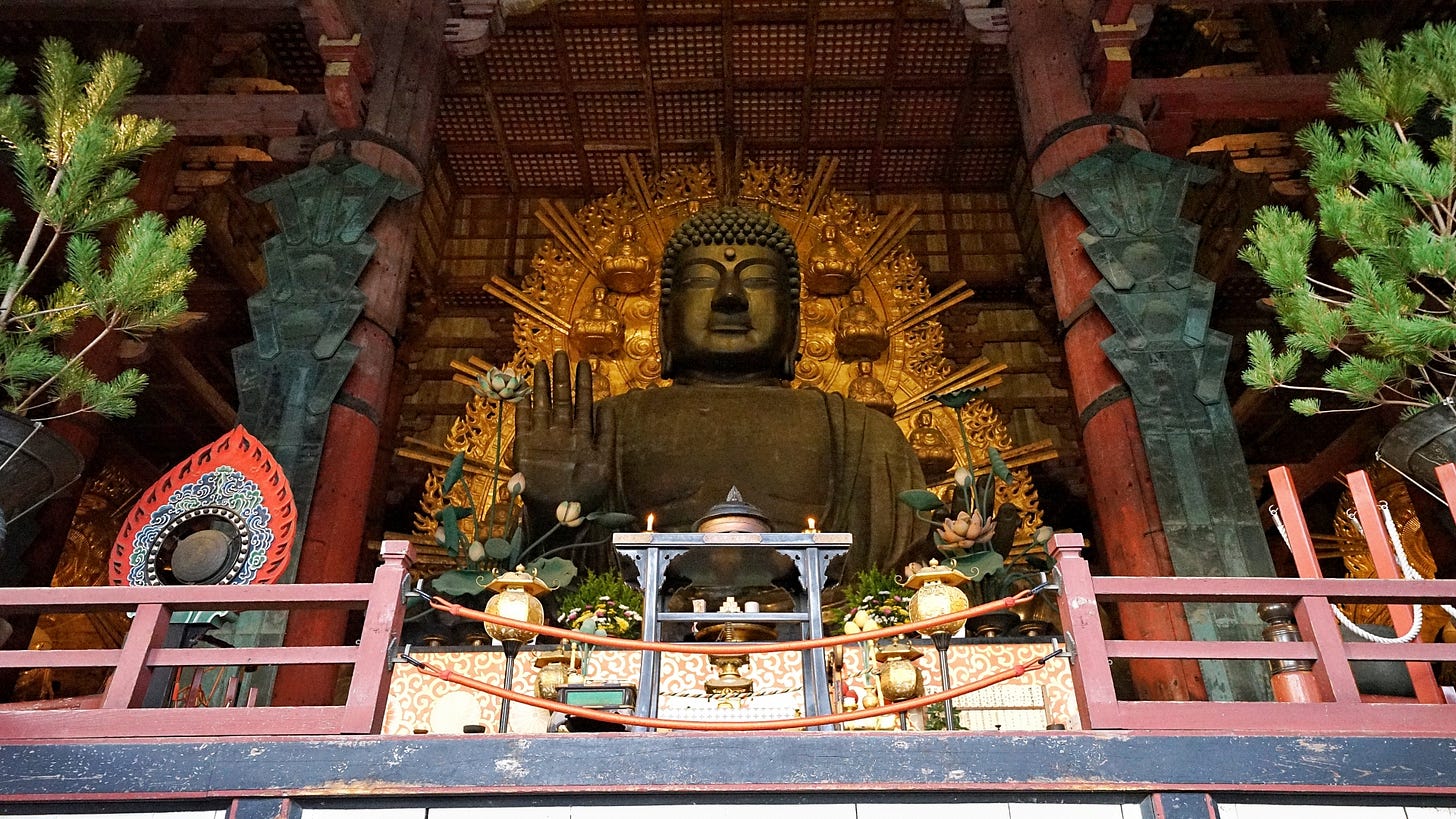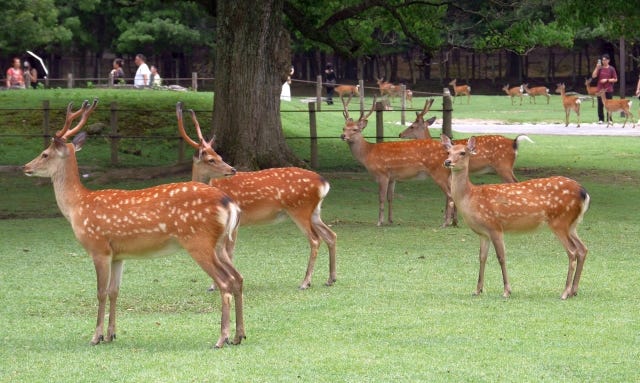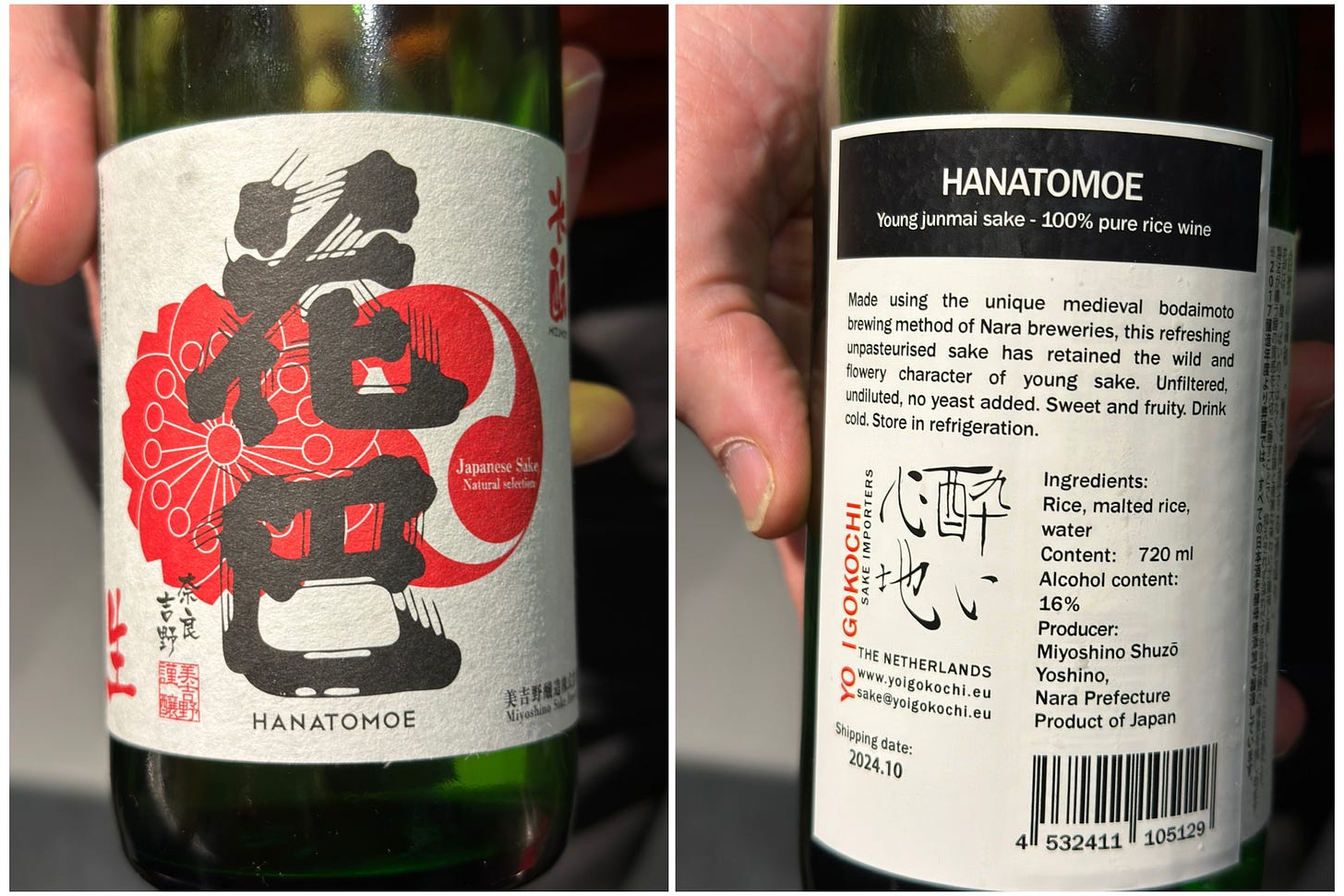Sake Atlas #3: Nara Prefecture - Where the Gods First Sipped Nihonshu
From Medieval Monasteries to Modern Glasses: The Birthplace of Japanese Sake Innovation
**🇯🇵 日本語版は記事の下部にあります / Japanese version available below**
This is part of our comprehensive guide exploring Japan's 20 most important nihonshu-producing regions, helping sake enthusiasts understand how geography and local traditions shape each area's unique brewing style.
Note: Nihonshu (日本酒) is the GI-protected official term for Japanese sake.
I'm Kazumi, a DipWSET wine and sake educator based in Amsterdam. With roots in both Japanese and European food cultures, I write to bridge these worlds, translating sake into the language of wine professionals. Each week, I explore a topic that demystifies sake, deepens your understanding, and equips you with practical knowledge for the floor or table.
Where Gods First Sipped Sake
Morning mist drifts around Mount Miwa like incense in an old temple. At the base of this sacred mountain—worshipped as a god itself—Japan's first sake breweries took root. Omiwa Shrine has stood here for thousands of years, watching sake brewing come to life. If you want to understand Japan, start with Nara. This isn't just another sake region—it's where the nation's soul and its favorite drink were born.
Here in landlocked Kansai, sake brewing runs as deep as the sacred cedars that shade these temples.
Thirteen centuries later, Nara isn't the biggest sake producer—it has a modest number of breweries and doesn't make massive volumes—but the stories here are incredible, stretching from ancient times to cutting-edge innovation.
Where Nations Are Born
Nara occupies a unique position in Japan's geography and psyche. Located about an hour inland from coastal cities like Osaka and Kobe, and from historical Kyoto, Nara turned inward and upward—toward the mountains, toward the gods, toward perfection in craft. This geographical positioning created something unique: an environment where various cultures and technologies could develop and mature slowly and carefully, like the finest sake.
Nara's story unfolds across three transformative chapters. First, Mount Miwa served as an important center of ancient worship where sake offerings were made to the gods. Rice cultivation and sake brewing using rice as a raw material are thought to have begun approximately 2,000 years ago. Next, in the 8th century, Nara became Japan's capital with the establishment of Heijo-kyo (710 CE), and major temples such as Todai-ji and Kofuku-ji were constructed. The monks who built these monuments brought not just spiritual teachings but sophisticated brewing techniques from the continent. During the time, when Nara served as Japan's first permanent capital, sake evolved from a divine offering into the favored drink of the powerful.
But it was when Nara became established as the center of sake brewing technology during the medieval period, particularly the Muromachi era (1336-1573), that its true transformation occurred. The birthplace of sake became a hub of technological innovation during this period. In the temple breweries, monks developed one revolutionary technique after another—fundamental technologies that remain essential to premium sake production today. As a result, brewers from across the country began visiting Nara's temples to learn advanced brewing techniques along with religious teachings.
Revolutionary Brewing Techniques
Nara's temple breweries pioneered a series of groundbreaking techniques that transformed sake from a cloudy, sweet beverage into today's refined beverage.
The three-stage brewing process made it possible to add ingredients in stages and precisely control fermentation. Furthermore, using polished white rice for both koji and steamed rice brought about a major transformation from the rough sake made with brown rice to a clear, elegant beverage.
The most revolutionary of these was bodaimoto, developed at Bodaisen Shoryaku-ji Temple in the 14th century. Monks succeeded in creating an acidic environment by steeping raw rice in water and utilizing natural lactic acid bacteria. This acidity suppressed harmful microorganisms and enabled stable fermentation. In an era without artificial cultures or modern equipment, this represented true medieval biotechnology—identifying and harnessing natural processes.
The Revival of Bodaimoto
This technique disappeared with modernization, dismissed as "inefficient." But in 1996, it came back into the spotlight when Nara breweries partnered with Shoryaku-ji Temple and the Nara Prefectural Industrial Technology Center to launch a project reviving this 500-year-old technique.
Today, Shoryaku-ji stands as the only temple in Japan licensed to produce yeast starter, conducting bodaimoto production every January. Monks and brewers work together to create the starter, which is then distributed to seven breweries, each crafting distinctive sake using techniques passed down from medieval times.
Among Nara's 38 breweries, not only traditional bodaimoto but also new challenges by younger generations continue. From low-alcohol undiluted sake without added water to experimental sake pursuing unique acidity and aromas, Nara's sake brewing continues to evolve.
The Nara That Most People Don't Know
When most people think of Nara, they think of deer—and for good reason. In Nara Park, approximately 1,200 deer roam freely, famously bowing to tourists for deer crackers. These deer have been cherished as divine messengers of Kasuga Taisha Shrine—one of Japan's most important Shinto shrines established in 768—for about 1,200 years. But Nara's appeal extends far beyond these charming creatures.
Nara's status as a treasure trove of cultural assets is evident in the numbers. The prefecture boasts as many National Treasure buildings as Kyoto, with 149 nationally designated historic sites scattered throughout. This density ranks among the highest in Japan. Heijo Palace Site, Todai-ji Temple, Kofuku-ji Temple, Kasuga Taisha Shrine—places essential to understanding Japanese history are concentrated here.
For sake brewing, water quality is paramount, and Nara excels in this regard. The Yoshino region, while famous for its cherry blossoms, is also a source of exceptional natural water. The prefecture contains multiple water sources selected for Japan's "100 Famous Waters" by the Ministry of Environment, and these pristine waters have sustained Nara's sake brewing tradition.
Walking through Nara in the early morning, you can sense why this place became a center of Japan's spiritual culture and technological innovation. The serene atmosphere of the ancient capital carries the weight of 1,300 years of history, yet feels surprisingly light—much like the deep flavor and refreshing finish of Nara's sake.
Featured Sake - Hanatomoe Mizumoto* Nama Genshu (Miyoshino Brewery):
*Mizumoto is the synonym of bodaimoto
About the Producer As a prime example of applying Nara's traditional techniques to the modern era, "Hanatomoe" by Yoshino Brewery exemplifies the application of Nara's traditional techniques. Established in 1912 in Yoshino, Nara prefecture, this brewery continues to innovate while preserving tradition.
Teruaki Hashimoto Toji for Yoshino Brewery, along with a small elite staff, takes a unique approach of crafting sake using rice sourced from contracted local farmers. Unlike typical sake breweries that specify particular sake rice varieties, they accept varieties that are easier for farmers to grow and create sake that brings out the individuality of each rice, instead of using only famous sake-specific rice.
Production Method Hanatomoe's most distinctive feature is fermenting exclusively with wild yeast that inhabits the brewery, completely avoiding cultured yeast. While common in wine production, this method carries high technical risks in sake brewing, which involves parallel multiple fermentation. Many breweries avoid this approach because it is likely to cause flavor variations between vintages and batches, and create distinctive flavors. However, this was the traditional sake-making method before cultured yeast appeared, and Yoshino Brewery deliberately chooses this path.
The bodaimoto starter they use suppresses harmful bacteria through an acidic environment created by natural lactic acid bacteria during fermentation. This production method creates a unique flavor profile where rich umami and vivid acidity coexist. This is junmai nama genshu - 100% pure rice, no addition of distilled alcohol, no water added, no pasteurization, no filtration.
Tasting Notes Aromas reminiscent of yogurt and cheese derived from lactic acid fermentation. On the palate, after juicy and rich umami, a characteristic sweet-and-sour acidity spreads. Citrus freshness and tropical fruit-like fruitiness flavor, with subtle sweetness and pleasant fermentation-derived bitterness maintaining overall balance. The finish is dry while the acidity persists, pairing particularly well with rich dishes, cheese, and fermented foods.
Distribution and Recognition Hanatomoe has gained high acclaim both domestically and internationally. Particularly in the Netherlands, the importer "Yoigokochi" emphasizes the uniqueness of "Nara's medieval bodaimoto production method," appealing to sake enthusiasts seeking tradition and authenticity. In today's relatively standardized sake market, the distinctive flavors created using 500-year-old techniques are recognized as new value.
From Nara to the World
Nara's example demonstrates that innovation doesn't necessarily mean rejecting tradition. The brewing techniques established by monks in the Muromachi period were methods that skillfully utilized the workings of microorganisms in nature through experience and observation. While they didn't know scientific theory, they established stable sake brewing techniques through practice.
The 14th-century monks could never have imagined that their techniques would one day be appreciated worldwide. Yet in reality, sake brewed with bodaimoto is now reaching sake enthusiasts across Europe, including the Netherlands. Techniques from over 500 years ago are creating new value in the global market.
Every time I taste bodaimoto sake, I'm reminded why Nara matters. It's not just about tradition or history—it's about monks who figured out fermentation centuries ago, and brewers today who still find value in their methods. That's a real story of Nihonshu.
日本酒の地図 #3:奈良県—神々が最初に酒を口にした場所
中世の寺院から現代のグラスへ:日本酒革新の発祥地
これは日本の20の重要な日本酒生産地域を探るガイドの一部で、地理と地域の伝統が各地域独特の醸造スタイルをどのように形作るかを海外の日本酒愛好家に理解してもらうため、JSAとWSETの知識および公式サイトの情報等を元に書いている。
神々が最初に酒を口にした場所
朝霧が古代の寺院の線香の煙のように三輪山にまとわりつく。山そのものが神として崇められるこれらの聖なる斜面のふもとで、大神神社は古来より何千年もの間変わらず、日本酒作りを見守ってきた。日本を理解するには、奈良から始めなければならない。ここは日本の酒地図上の単なる一点ではなく、日本の魂とその最も大切な飲み物の発祥の地。
ここ、関西地方の内陸の中心部奈良県では、日本最古の神社が守る神聖な杉のように、酒造りがこの土壌に深く根を張っている。
それから13世紀後の現在、奈良は日本酒地域としては、決して大きくはない(醸造所数全国18位の38場、生産量27位の2,192kL)が、古代の歴史と現代の進化に根ざした素晴らしい物語を持っている。
日本酒発祥の地*、奈良県へようこそ。
*諸説ある
日本酒が生まれた場所
奈良は日本の地理と精神において特別な位置を占めている。大阪や神戸のような沿岸都市からも京都から小1時間程内陸に位置する奈良は、外ではなく内へ、そして上へ―山へ、神々へ、技の極みへと向かった。この地理的な条件が、思いがけない結果を生んだ。様々な文化や技術が、上質な酒のようにゆっくりと、慎重に発展・成熟できる環境を作り出したのである。
奈良の歴史は三つの大きな転換点を持つ。まず、古代より大神神社がある三輪山は重要な信仰の中心地であり、酒が神々に捧げられてきた。日本に稲作が伝わり、米を原料とする酒造りが始まったのは、縄文時代後期から弥生時代初期(約2000年前)と考えられている。次に8世紀、平城京遷都(710年)により奈良は日本の首都となり、東大寺や興福寺などの大寺院が建立された。これらの寺院を建てた僧侶たちは、仏の教えとともに、大陸から高度な醸造技術も持ち込んだ。奈良が日本初の恒久的な都となった時代に、酒は神への供物から、権力者たちが愛飲する酒へと変化していったのである。
しかし奈良が酒造技術の中心地として確立されたのは、中世、特に室町時代(1336-1573)。日本酒発祥の地であった奈良は、この時期に技術革新の拠点となり、寺院の醸造所で、僧侶たちは現代の高級酒造りにも欠かせない基本技術を次々と開発していった。その結果、全国の醸造家たちが奈良の寺院を訪れ、宗教的な教えとともに、先進的な醸造技術を学ぶようになったのである。
日本の酒造技術を変えた革新
奈良の寺院醸造所は、かつて濁った甘い飲み物だった酒を、今日の洗練された清酒へと変える画期的な技術を次々と生み出した。
まず三段仕込みによって、原料を段階的に投入し、発酵を精密にコントロールすることが可能になった。さらに、麹米と掛米の両方に精白米を使用する諸白造りは、玄米を使っていた従来の粗い酒から、透明で上品な酒への大転換をもたらした。
なかでも革命的だったのが、14世紀に菩提山正暦寺で開発された菩提酛(ぼだいもと)である。僧侶たちは生米を水に浸け、自然の乳酸菌を利用して酸性の環境を作り出すことに成功した。この酸が有害な微生物を抑制し、安定した発酵を可能にしたのだ。人工的な培養菌も近代的な設備もない時代に、自然界の仕組みを見抜いて活用した、まさに中世のバイオテクノロジーだった。
菩提酛の復活
近代化とともに「効率が悪い」として姿を消したこの技術に、再び光が当たったのは1996年のことだ。奈良の酒蔵と正暦寺、そして奈良県産業振興総合センターが手を組み、500年前の技術を現代に蘇らせるプロジェクトが始動した。
今では正暦寺が日本で唯一、酒母製造免許を持つ寺院として、毎年1月に菩提酛の仕込みを行っている。僧侶と蔵人が共同で仕込んだ酒母は7つの酒蔵に分けられ、それぞれが中世から続く技術で個性豊かな酒を醸している。
県内38の酒蔵では、伝統の菩提酛だけでなく、若い世代による新たな挑戦も続いている。水を加えない低アルコール原酒、独特の酸味や香りを追求した実験的な酒など、奈良の酒造りは今も進化を続けている。
知られざる奈良の実像
奈良といえば「鹿」—これが多くの人の第一印象だろう。奈良公園では約1,200頭の鹿が自由に歩き回り、観光客から鹿せんべいをもらってお辞儀をする姿が有名だ。この鹿たちは春日大社創建以来、約1,200年にわたって神の使いとして大切にされてきた。
しかし、奈良の魅力は愛らしい鹿だけにとどまらない。文化財の宝庫としての奈良の実力は、数字が物語っている。国宝建造物の数は京都に匹敵し、県内には149もの国指定史跡が点在する。この密度は全国でもトップクラスだ。平城宮跡、東大寺、興福寺、春日大社など、日本の歴史を理解する上で欠かせない場所が集中している。
日本酒造りにとって最も重要なのは水質だが、奈良はこの点でも恵まれている。特に吉野地域は、桜の名所として知られる一方で、良質な天然水の産地でもある。県内には環境省選定の「名水百選」に選ばれた水源が複数存在し、これらの清冽な水が奈良の酒造りを支えてきた。
早朝の奈良を歩けば、この地が日本の精神文化と技術革新の中心地となった理由が体感できる。古都の静謐な空気は、1,300年の歴史の重みを感じさせながらも、不思議と軽やかだ。それはまるで、奈良の酒が持つ深い味わいと爽やかな余韻のようである。
注目の日本酒—花巴 水酛無濾過生原酒(美吉野醸造):
生産者について
奈良の伝統技術を現代に活かす代表例として、美吉野醸造の「花巴(はなともえ)」がある。1912年に吉野で創業したこの蔵は、伝統を守りながら革新を続けている。
美吉野醸造の橋本晃明氏は、少数精鋭のスタッフとともに、地元農家が栽培する米の特性に合わせて酒造りを行うという独自のアプローチを取っている。一般的な酒蔵が特定の酒米を指定するのとは逆に、農家が作りやすい品種を受け入れ、その米の個性を活かした酒造りだ。
製造方法
花巴の最大の特徴は、培養酵母を一切使用しない点にある。蔵に住み着く野生酵母のみで発酵させるという、現代では極めて稀な手法を採用している。ワインでは一般的なこの方法は、並行複発酵を行う日本酒醸造においては技術的にリスクが高い。ビンテージや仕込みごとに味わいが変化し、また独特の風味が生まれるため、多くの蔵元が避ける方法だ。しかし、これは培養酵母が登場する以前から行われていた伝統的な酒造りであり、美吉野醸造はあえてこの道を選んでいる。
使用する菩提酛は、自然の乳酸菌による酸性環境で雑菌を抑制しながら発酵させる。この製法により、豊かな旨味と鮮烈な酸味が共存する独特の味わいが生まれる。加水なし、火入れなし、濾過なしの純米生原酒として出荷される。
テイスティングノート
乳酸発酵由来のヨーグルトやチーズを思わせる香り。口に含むと、ジューシーで豊かな旨味の後に、特徴的な甘酸っぱい酸味が広がる。柑橘系の爽やかさとトロピカルフルーツのようなフルーティーさが感じられ、ほのかな甘みと発酵由来の心地よい苦味が全体のバランスを保つ。余韻はドライながら酸味が持続し、濃厚な料理やチーズ、発酵食品との相性が特に良い。
流通と評価
花巴は国内外で高い評価を得ている。特にオランダでは輸入業者『酔い心地』が「奈良の中世から続く菩提酛製法」という独自性を前面に出し、伝統と真正性を求める日本酒愛好家に訴求している。画一化が進む現代の日本酒市場において、500年前の技術を活用した独特の味わいが、新たな価値として認識されている。
奈良から世界へ
奈良の事例が示すのは、革新が必ずしも伝統の否定を意味しないということだ。室町時代の僧侶たちが確立した醸造技術は、経験と観察を通じて自然界の微生物の働きを巧みに利用する方法だった。彼らは科学的な理論こそ知らなかったが、実践を通じて安定した酒造りの技術を確立していたのである。
14世紀の僧侶たちは、自分たちの技術がいずれ世界中で評価されるとは想像もしなかっただろう。しかし現実に、菩提酛で醸された日本酒は今、オランダをはじめヨーロッパ各地の日本酒愛好家に届いている。500年以上前の技術が、グローバル市場で新たな価値を生み出している。
菩提酛の日本酒を口にするたびに、なぜ奈良が重要なのかを改めて考える。それは単なる伝統や歴史の話ではない。何世紀も前に発酵の仕組みを解き明かした僧侶たちと、今日でもその方法に価値を見出し続ける醸造家たちの物語として。
「世界を合わせるペアリング:ワイン、日本酒、その他」をお読みいただき、ありがとうございます!いいね、コメント、スタック、購読でサポートしていただけると嬉しいです。



